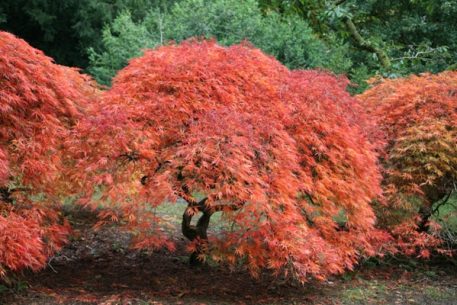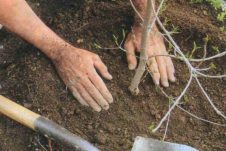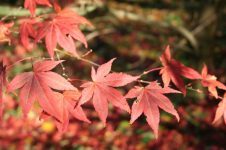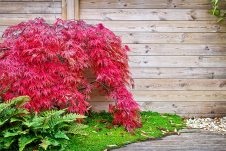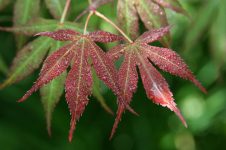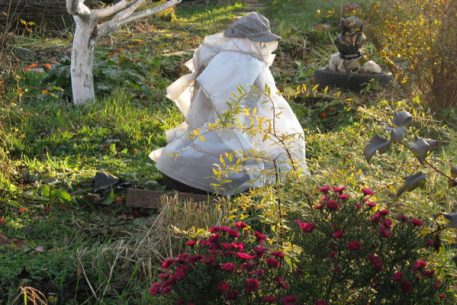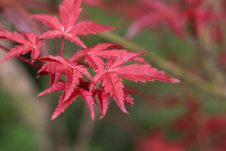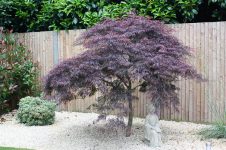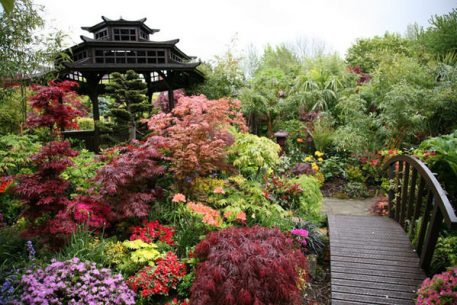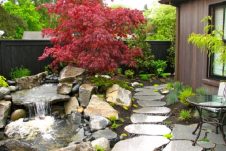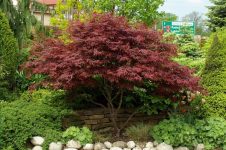Among the decorative trees, maples with colorful foliage are very popular. Japanese maple is distinguished not only by red leaves, but also by an unusual crown, which has many thin branches. This becomes noticeable in winter when the branches are bare. Let us consider in more detail the characteristic features of the plant.
Material Content:
Description of varieties
The culture is represented by three basic varieties and many bred hybrid.

Base varieties:
- Japanese.
- Japanese fan.
- Crescent-shaped.
They differ in the shape of the leaves, their various colors and the shape of the crown.
- Japanese maple. The plant is suitable for greenhouses or places with a warm climate. It does not tolerate frost. It is characterized by graceful leaves. They change color over the period of their existence: from green in spring to autumn yellow and red shades.
- Japanese fan. These are low trees with an unusual crown. Lacy leaves, shaped like a fan, are characterized by a red or golden color.
- Crescent-shaped. The most beautiful plant in the Japanese maple family. It is interesting in the form of palm-like leaves with 5 to 9 fingers. They have a burgundy color throughout the warm period. The culture grows slowly, reaches 5 meters in height, the crown is 3 meters in diameter.
Of hybrid varieties, the following trees are especially common:
- "Shirasawa." Short stature, not more than one and a half meters. Yellow-orange leaves have a dark edging.
- Bloodgood has ink foliage.
- The variety “Beni Cava” ruby bark and red leaves.
- Shino Buga Oka, dwarf view of meter height. The tree is very spreading. Foliage changes color from bright green in summer to yellow-orange in autumn.
Maple planting in open ground
Landing of Japanese maple begins with the preparation of the landing pit. It depends on the size of the seedling. The volume should be twice as large as the root lobe with a lump of earth. The soil requires slightly acidic or neutral, breathable, enriched with humus or compost.
The seedling should not be buried any more than it grew in the container. It is necessary to carefully fill the voids, slightly tamping the soil. Next, you need to water, you can re-water the tree after absorbing the first portion of water. The trunk circle must be mulched.
Agrotechnics of cultivation and care
This is a pretty picky plant. It requires regular watering, and in arid times, young plantings in the evening are useful to spray water on the crown. After the snow melts, the first top dressing is done, sprinkling granular fertilizers around the trunk. On poor soils, fertilizer is also applied in the summer. Do not use nitrogen supplements for Japanese maple.

You can not plant colorful views in the bright sun, they will lose their decorative effect. The best places to place Japanese maple where they are illuminated in the morning and evening. At noon, the culture should be obscured by other plantings or buildings.
The soil around the tree must be mulched with compost, bark or humus. This will protect the roots from drying out and freezing in the fall and spring.
Cropping and shaping the crown
Usually these trees form the first time after planting. In the future, they do not require trimming. The beauty of the crown is achieved in a natural way, the tree itself branches well and forms a cloud of branches characteristic of Japanese design.
It is necessary to trim old drying branches, which worsen the appearance and are a place for the propagation of pests. Another pruning is important to make the crown airy, to remove thickening shoots, to allow good ventilation.
It should be remembered that pruning can be done when the tree is at rest. The best time for this is after flying around the foliage in the fall.
Plant propagation methods
The main way to propagate Acer japonicum is by sowing seeds. They ripen in October, and they must be collected immediately. Store material in the winter in a cool dry place. It does not retain viability for long, therefore maples are sown in April next year.

- Sowing is carried out in containers.
- For better germination, seeds are treated with growth stimulants.
- Over the summer they grow little, leaving only strong shoots. The grown seedlings are kept in the winter in a room with a positive temperature.
- Wintered plants are transplanted into pots, which are placed in the shady corner of the site.
- When the seedlings grow to 30 cm, they can be transplanted into the open ground.
- It is permissible to plant maples in tubs. In this case, you need to monitor the fertility of the soil in the tank. Such a plant will need additional top dressing.
Another method of reproduction is to use grafting of cuttings on a strong stock.
Japanese Maple Wintering
Young seedlings for the winter should be covered especially carefully. A small hut made of covering material is arranged over the plant, and it is covered with fallen leaves and covered with branches so that the wind does not stir up it. The roots are mulched with humus or peat.
As the plants grow, shelter is increased, spruce paws are laid on top. Mulching of roots is used for plants of any growth and age.
If you want to grow Japanese maple in the northern regions, use low-growing varieties planted in large pots. In this case, you need a cool room to keep the plant in winter.
Disease and Pest Prevention
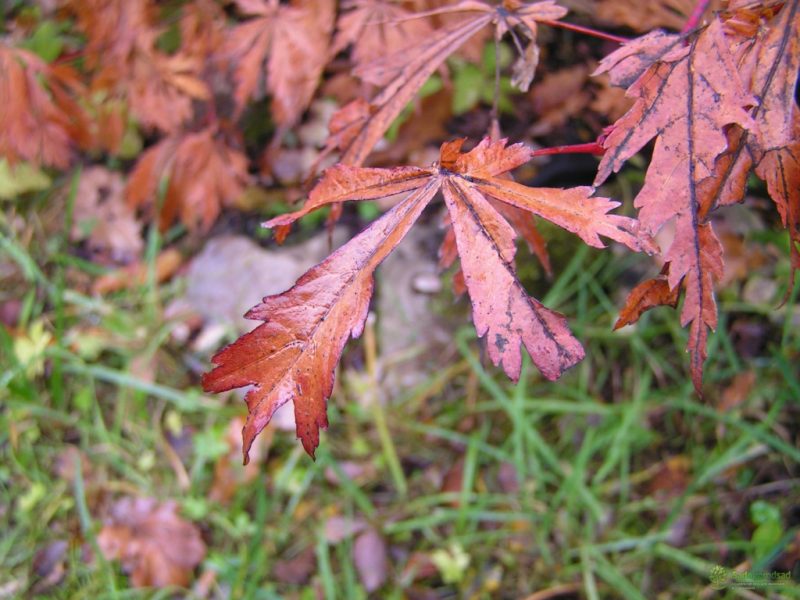
Maple is besieged by pests that are dangerous for almost all deciduous trees. It:
- Maple weevil.
- Caterpillars.
- Leaf beetles.
- Khrushchev.
Among the diseases, powdery mildew and black spotting are the most dangerous.Diseases should not only be fought, but they should be avoided. For this, various processing methods are used.
- In the spring, spraying with solutions of various preparations and fungicides will help prevent the appearance of powdery mildew. Good use shows Bordeaux fluid.
- From harmful insects, trees are treated with biological preparations Iskra-Bio, Fitoverm, Healthy Garden. An effective and long-acting means of "Aktara", however, it is quite poisonous.
- The use of folk recipes for the preparation of protective agents is justified. But it is worth considering that they have a more repelling effect.
It is interesting:kiwi
Landscape design
Japanese decorative maple takes pride of place in the design of gardens and park areas.
- The culture is used not only to create exotic Japanese kindergartens, but also add emphasis to various compositions with its help.
- Tall varieties of maple can be used as distinctive elements on a large lawn or lawn.
- Planted backstage along the paths, they will create a pleasant shadow.
- You can arrange decorative thickets by planting ferns and rhododendrons, Volzhanka and other shade-loving plants under maple. Lacy shadow of maple will create favorable conditions for their growth.
- Under this tree, shrubs such as cotoneaster, cinquefoil, and undersized viburnum bushes will look good.
The variety of species of Japanese maple makes it possible to choose a plant for your site to any, the most picky person. Experienced gardeners argue that Japanese maple is not such a moody plant, as they usually write about it. If you properly care for and take into account his needs, you can give your garden a bright note and Japanese flavor.


